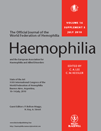Update on pathogenesis of the bleeding joint: an interplay between inflammatory and degenerative pathways
In the pathogenesis of blood induced joint damage as seen in haemophilic arthropathy, both inflammatory changes in synovial tissue and degenerative changes in cartilage are involved. Natural evacuation of blood from the joint cavity leads to deposition of iron (haemosiderin) in the synovial tissue. This results in proliferation and hypertrophy of the synovium, fibrosis, and neovascularization. Infiltration of the synovial tissue with lymphocytes results in an inflammatory reaction, contributing to cartilage damage. Recently it has been demonstrated that induced joint bleeds in haemophilic mice lead to elevation of pro-inflammatory cytokines (IL-1β, IL-6, KC and MCP-1) in the synovial fluid [1], supporting the existence of an inflammatory synovial component in pathogenesis of haemophilic arthropathy. These released cytokines will have repercussions on cartilage integrity.
The devastating effects of joint bleeding are also evident independent of synovial inflammation. Exposure of cartilage tissue in vitro to whole blood (50% volume/volume) for 4 days leads to disturbance of cartilage matrix turnover. This is expressed by an inhibited synthesis of one of the major matrix components, aggrecan, and an increased breakdown of these molecules, important for resilience of the tissue. These changes lead to in an impaired matrix integrity as measured by a diminished glycosaminoglycan content of the tissue [2]. Even after a follow-up period of 10 weeks matrix synthesis is still inhibited [3]. The in vitro experiments mimic the natural joint haemorrhage, as 4 days is considered to be the natural evacuation time in humans. These effects were confirmed by canine in vivo experiments. Injections of autologous blood decreased matrix synthesis and content, and enhanced release of matrix components. The effects persisted for a prolonged period of time despite an apparently ineffective repair activity [4]. However, finally repair activity prevailed and cartilage damage vanished [3]. Preliminary results of recent studies demonstrated that sufficient repeated joint bleeds finally lead to persisting cartilage damage (ongoing work of van Meegeren).
Clearly the effects in dogs were less severe than in vitro. It was demonstrated that blood was cleared from the canine joint much quicker than generally observed in humans. After injection of a maximum amount of blood in the canine knee joint, the volume of blood decreased to less than 5% within 48 hours [5]. In vitro it was found that exposure to a concentration of at least 10% for more than 2 days was needed to maintain the irreversible adverse effects [6].
Disturbance of matrix turnover in the long-term is considered to be caused by apoptosis of the chondrocyte. Inhibition of caspases, involved in the apoptotic process, results in normalization of matrix synthesis [7]. Since the low proliferating chondrocyte is the only cell type of cartilage and is responsible for production and maintenance of the extracellular matrix, apoptosis of chondrocytes will result in a long-lasting, if not permanent, impaired matrix turnover. In that condition, cartilage will be unable to handle normal loading resulting in further damage of the tissue, as supported by canine in vivo studies [8].
In vitro studies revealed that the combination of mononuclear cells (MNC) and red blood cells (RBC) present in whole blood can have the same effect on their own as whole blood. A possible explanation for the irreversible damage by this combination is the conversion of hydrogen peroxide, produced by IL-1 activated monocytes/macrophages, and a catalyst in the form of iron supplied by RBC, into hydroxyl radicals. Scavenging these hydroxyl radicals with e.g. dimethylsulphoxide (DMSO) diminishes inhibition of matrix synthesis [9].
Apoptosis of chondrocytes can be inhibited by addition of IL-10 [10]. Most recently it appeared that IL-4 has even more protective effects on blood-induced cartilage damage than IL-10 (manuscript in preparation). It has been reported that IL-4 and IL-10 alone and in combination are able to inhibit inflammation in arthritic conditions [11]. This merges the direct degenerative activity of blood on cartilage with the inflammation driven activity of repeated joint bleeds. In vivo experiments where blood induces inflammatory and degenerative changes have to confirm the protective effects of these cytokines and might provide tools for treatment in case prophylaxis failed.




